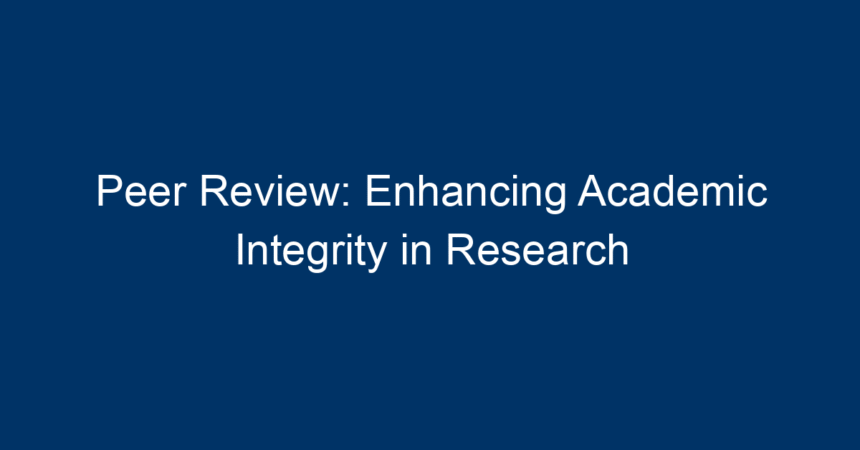Introduction
In the world of academia, trust is fundamental. Researchers build upon one another’s work, creating a complex web of knowledge that drives innovation and discovery. However, the integrity of this web can easily be compromised without adequate safeguards. Peer review serves as a cornerstone of academic integrity, providing a structured system of checks and balances that not only evaluates the quality of research but also upholds ethical standards. This article delves into the importance of peer review in maintaining academic integrity, explores the process, highlights its benefits, and discusses best practices for researchers and institutions.
What is Peer Review?
Peer review is a systematic process in which research manuscripts are evaluated by “peers” or subject-matter experts before they are published in academic journals. This process serves multiple purposes:
- Quality Control: Ensures the research meets the standards of the journal and the field.
- Validation: Confirms the findings through expert scrutiny.
- Improvement: Offers constructive criticism that can enhance the manuscript before publication.
Types of Peer Review
There are several types of peer review commonly used in academia:
- Single-Blind Review: The reviewers know the authors’ identities, but the authors do not know who the reviewers are.
- Double-Blind Review: Neither the reviewers nor the authors know each other’s identities, promoting unbiased evaluation.
- Open Review: Both identities are known, and reviewers may even provide comments openly, fostering transparency.
By understanding the types of peer review, authors can make informed decisions on where to submit their work and how their manuscripts will be evaluated.
The Role of Peer Review in Academic Integrity
Academic integrity is hinged on the ethical conduct of research and the honest representation of findings. Peer review plays a crucial role in enhancing academic integrity in several ways:
1. Ensuring Credibility
Research findings must be credible to be impactful. Peer review acts as a validating process, wherein experts analyze the methodology, data, and conclusions of a study. This scrutiny helps reduce the likelihood of fraud and errors that could mislead future research.
2. Preventing Plagiarism
By involving multiple reviewers, the peer review process increases the chances of detecting potential plagiarism. Reviewers often have extensive knowledge of the literature in their field, equipping them to identify unacknowledged sources or improper citations.
3. Upholding Ethical Standards
Peer reviewers are not only evaluating the technical aspects of the research but also its ethical implications. This includes checking for ethical approval of studies involving human or animal subjects and ensuring that authors have adhered to guidelines for responsible conduct in research.
The Peer Review Process: A Step-by-Step Overview
Understanding the peer review process can demystify how research is evaluated and published. Below are the typical stages involved in peer review:
Step 1: Manuscript Submission
Authors submit their manuscripts to a journal, specifying the relevance of their research and its contribution to the field.
Step 2: Initial Screening
Journal editors conduct an initial screening to assess the manuscript’s alignment with the journal’s scope and standards. Manuscripts that do not fit may be rejected outright.
Step 3: Reviewer Selection
Editors select a pool of qualified reviewers based on their expertise and geographical neutrality, ensuring a fair evaluation.
Step 4: Reviewer Evaluation
Reviewers evaluate the manuscript based on criteria such as originality, significance, methodology, and overall presentation. They often provide detailed feedback and recommendations for improvement.
Step 5: Editorial Decision
Based on the reviewers’ feedback, the editor makes a decision to accept, request revisions, or reject the manuscript.
Step 6: Final Publication
If accepted, authors make necessary adjustments, and the manuscript is published, contributing to the academic conversation.
Benefits of Peer Review
The benefits of peer review extend beyond just authors and journals. Here’s how various stakeholders benefit:
For Authors
- Enhanced Quality: Constructive feedback leads to improved manuscripts and better research outcomes.
- Increased Credibility: Published papers in peer-reviewed journals carry more weight in the academic community.
For Research Institutions
- Validation of Research: Institutions can demonstrate the quality and rigor of their research outputs.
- Attracting Funding: High-quality publications can enhance an institution’s reputation and attractiveness to potential funding bodies.
For Readers and the Public
- Trustworthy Research: Peer-reviewed articles ensure that readers consume credible and validated information.
- Informed Decision-Making: Policymakers and practitioners rely on peer-reviewed research to make informed decisions affecting public health and policy.
Challenges Facing Peer Review
While peer review has numerous advantages, it is not without its challenges:
1. Reviewer Bias
Subjectivity can sometimes infiltrate the peer review process, leading to biased evaluations that do not accurately reflect the quality of the research.
2. Time-Consuming Nature
The peer review process can be lengthy, leading to delays in publication. This can hinder the dissemination of important findings, especially in fast-moving fields.
3. Increased Pressure on Reviewers
Peer reviewers often take on this responsibility in addition to their own workloads. This can lead to reviewer fatigue and a decline in the quality of evaluations.
4. Emergence of Predatory Journals
The rise of predatory journals that claim to offer peer review but do not uphold academic standards has further complicated the landscape, making it essential for authors to conduct due diligence when selecting publishing outlets.
Best Practices for Enhancing the Peer Review Process
To address these challenges and enhance the peer review process, various best practices can be adopted:
1. Promote Transparency
Encouraging open forms of peer review can help mitigate biases by allowing for broader scrutiny of the evaluation process.
2. Streamline Processes
Using technology can help facilitate faster reviews and reduce the time it takes to publish valuable research.
3. Educate Researchers
Training programs on ethical research practices and proper peer review processes can empower both authors and reviewers, fostering a culture of integrity.
4. Implement Comprehensive Guidelines
Journals should provide clear guidelines regarding the expectations of peer reviewers to ensure consistency and quality in evaluations.
Conclusion: Embracing Peer Review for a Brighter Future
Peer review is more than just a procedural formality; it is a fundamental mechanism that enhances academic integrity in research. By promoting trust, quality, and ethical standards, peer review paves the way for credible scientific advancement. Researchers, institutions, and the wider academic community must work together to address the challenges facing this crucial process, ensuring that peer review continues to fulfill its vital role.
Actionable Insights
- Participate in Peer Review: If you are an experienced researcher, consider reviewing manuscripts to contribute to the community.
- Choose Wisely: When submitting your work, research the journal’s reputation and peer review policies.
- Seek Feedback Early: Don’t wait for formal review; seek informal feedback from colleagues before submission.
- Stay Educated: Keep abreast of developments in peer review processes and guidelines to ensure your research meets evolving standards.
In the dynamic field of research, maintaining academic integrity through peer review is essential for fostering trust and advancing knowledge. Let us commit to upholding these principles as we navigate the complexities of research and discovery.




